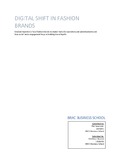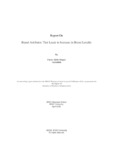| dc.description.abstract | Digital Marketing consists of mainly three types or areas of Digital Media which are: Blogs, Search Engine Optimization (SEO) or Marketing and Social Media. In today’s time, the digital space is the medium with the most easily accessible pool of consumers as well as the most efficient way to reach the consumers. As of May 2017, there are 20 Million active mobile social media (Facebook) accounts in the country which gives Brands close to 25%of the Active Internet population to talk to. Given that Digital is the only media with two-way active communication possibilities, the opportunities are immense for brands. Right at this very moment in the last 10 minutes, there are almost 20+ new Bangladeshis born, 60 new Facebook users activated and 120 new mobile subscribers added to the base; that is how swiftly the digital revolution is happening in Bangladesh. Of the total 20 Million Facebook users in the country, 85% are Millennials among which 79% are male users who are mostly interested in Technology, Sports, Fashion and Music. There are 8 Million people who access internet through normal mobile devices and almost 4 Million who access through smartphones. As the world grapples with social media and its impact on our everyday lives, so do marketers. They are plugging in to keep in touch with consumers, to inform them, to fight public relation battles, to research or gives them news or information, among other things. The social media loop is also a convenient way for companies to complete the feedback loop. What was once a one-way road for advertising has turned into a conversation between a brand and the consumers. Brands such as Aarong, Ecstasy, Noir and others now use Facebook, Twitter, Pinterest and YouTube, among other social platforms, to get consumer feedback, to do research and to benchmark themselves against competitors as well as integrate different forms of content creation to keep the consumers entertained as well as informed about what the brands are up to. This allows the consumers to perceive the said brands as identities on the internet they can communicate with, giving them an addition layer of brand loyalty. Traditional media follows a “push” strategy, where content is forced on you whether you want it or not. For instance, people cannot customize what ad they want to see after their favourite TV show. In Digital Media, customers have this choice. This allows for greater potential of creating brand loyalty.
The growth of digital media is inevitable. With an internet penetration rate of 24.5%, an internet user base of 40 million, and an ever-growing digital infrastructure, companies are bound to invest in digital marketing sooner or later. Expert interviews reveal that the digital marketing industry will undergo exponential growth over the coming years with current agencies to grow larger, and new ones to launch. While the share of the advertising industry in 2014 was 2%, it is expected to grow to 5% in 2015, 10% in 2016, and has achieved a growth of 17% in 2017. Content development and Digital Media marketing are the most popular services that digital agencies offer at the moment. Content has always been the core of any form of communication, making it one of the top services. Since Facebook is almost synonymous with the internet in Bangladesh, companies invest quite heftily in managing and growing their presence on the platform. This paper talks about the shift from traditional forms of advertising to the digital media and how much it has developed the marketing scenario in Bangladesh, especially for fashion brands who have the top presence in the digital space. From demographic-specific delivery of advertisements to online sales, this paper discusses the digital footprint of the fashion industry. | en_US |




